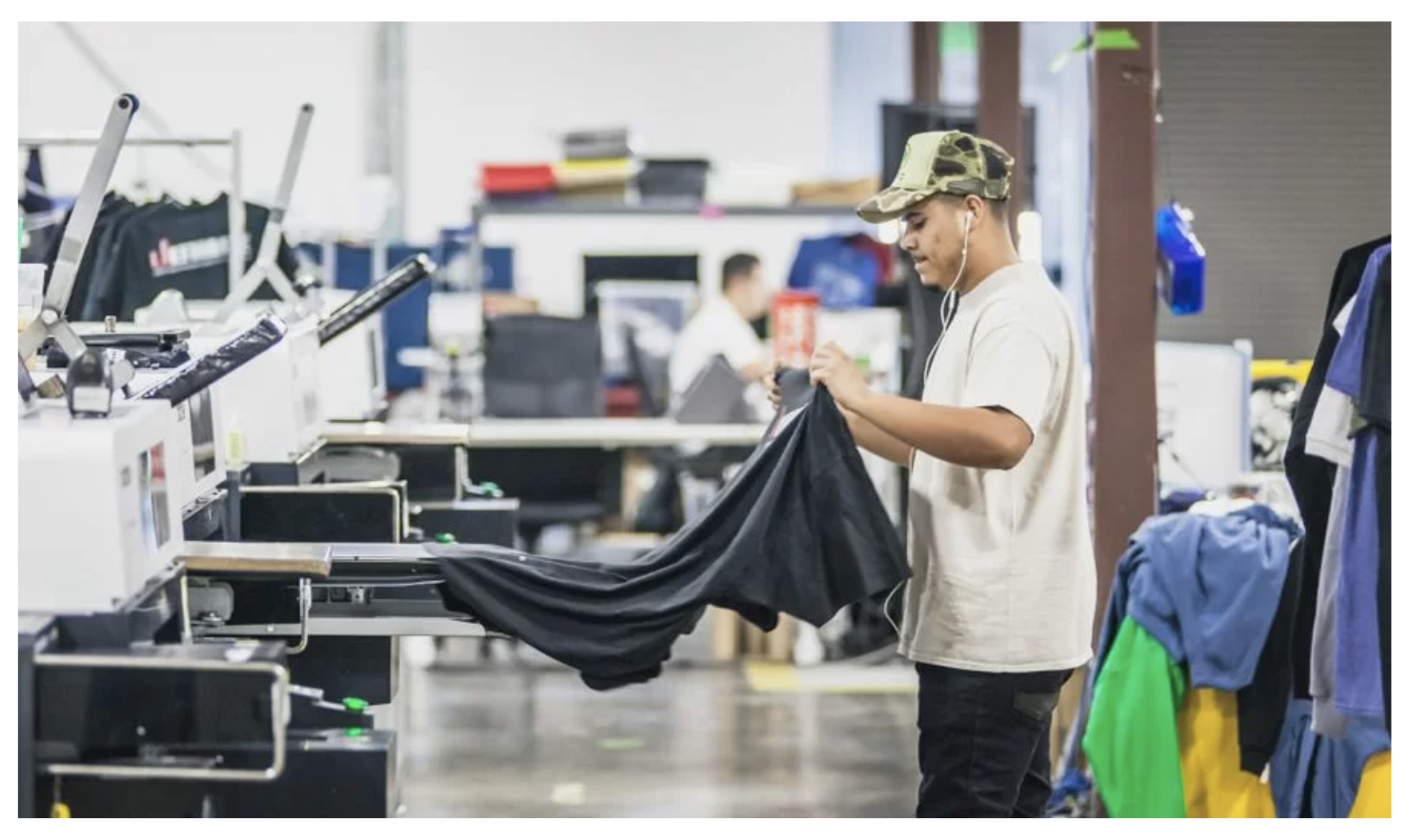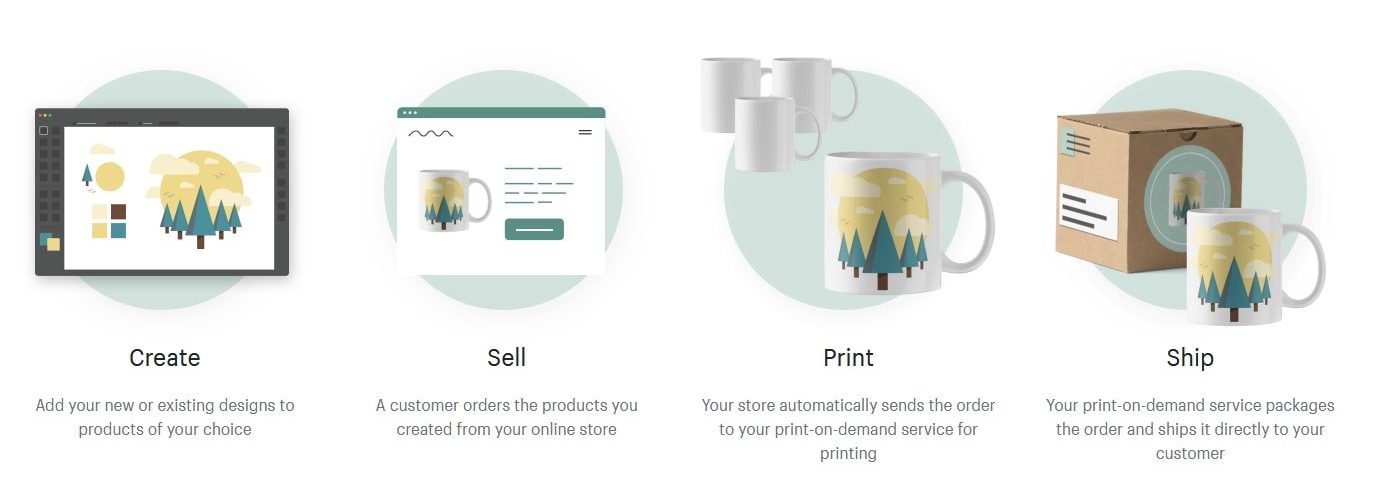With the massive expansion and adoption of the e-commerce business model during the pandemic, related order fulfillment methods naturally follow suit. One of these is print on demand, otherwise known as on-demand printing. This business model allows entrepreneurs to accept orders for customized products, and produce the product only after a customer has placed an order. Print on demand is closely linked to dropshipping. A retail fulfillment method, dropshipping is when a third party purchases the item from the entrepreneur or manufacturer as needed, then handles the shipping process. The latter includes packing orders, shipping orders, handling returns, and managing stock levels.
Creatives, designers, artists, and entrepreneurs may customize everything from clothing, stickers, face masks, phone cases, wall art, clocks, coasters, comforters, pillows, mugs, shower curtains, pins, water bottles, bags, and stationery. In other words, if one can print a custom design on a product, then that product may be sold at a print on demand for e-commerce platform.
Features of print on demand for e-commerce
Several features make the print on demand business model and order fulfillment method unique and attractive.
#1 The elimination of the need for a large inventory.
Because items are only created once an order has been placed, it is unnecessary to produce large quantities of items and oversee their management and storage in a warehouse. This lack of the need for a large inventory means much lower overhead costs for the entrepreneur, as compared to when one opts for a traditional brick-and-mortar business. In fact, many print on demand business survive with only a basic laptop or mobile device and pay for only a few recurring expenses, depending on the volume of orders. Many e-commerce platforms also simplify this management process with the use of apps.
Overhead costs are covered by print on demand companies such as Printful. Image Source: Printful
#2 Flexibility in location
Print on demand allows for literally anyone with an Internet connection to engage in the business. This means one does not have to be in a particular city or country to reach the consumers in that area. As travel restrictions continue to be in place because of the pandemic, flexibility in location is a valuable quality of this business model, providing entrepreneurship opportunities for anyone, anywhere.
Print on demand companies provide website and apps to allow customers to customize their desired products. Image Source: Boutique Setup
#3 Useful in testing demand and customer appetite
Because there is no need to commit to a large number of inventory items, many entrepreneurs favor the print on demand model to test whether customers like their products. This makes it an excellent avenue to offer novel product lines, additional product categories, and items that are considered on-trend without the involvement of immense risks and investment.
Some examples of products that can be ordered via print on demand. Image Source: Gumroad
#4 Easy scaling
Business growth, particularly in terms of an increase in the volume of orders, inevitably means a need for increased resources. In the print on demand for e-commerce model, however, these increased resources are typically shouldered by the e-commerce platform. There is no need, therefore, to hire additional employees in the event that the business grows, for example, double or triple its original scale.
Printful is a one of the print on demand companies that provides automated order fulfillment allowing customers to spend more time scaling their business. Image Source: Printful
#5 Wide selection of products
Print on demand for e-commerce makes it easy for entrepreneurs to offer an extensive array of products to meet the shifting tastes, preferences, needs, and trends–again, because there is no need to have these items physically in stock before an order is placed. Often, there is also no required order minimum. Creative entrepreneurs may let their imagination run wild as to what they believe the market might want, without fearing the high risk and cost of production.
#6 A chance to monetize creativity
Lastly, print on demand for e-commerce allows artists and designers to monetize their creativity. Many of these artists and designers have strong social media following and want to cater to their fan base’s demand. Print on demand enables them to offer a wide range of merchandise, which can be an added income source, as they focus on their regular creative work.
An example of product options from print on demand. Image Source: Envato
Limitations and challenges in print on demand for e-commerce
Before an entrepreneur commits to this business model, some limitations, challenges, and concerns must be considered.
#1 Quality assurance
Many entrepreneurs fully entrust the entire selling process to the print on demand e-commerce platform, from production to responding to customer inquiries to packaging, shipping, and returns. Once they have uploaded their designs, many prefer to sit back and wait for the commission to roll in. But this means they do not get an opportunity to see and touch the item they are selling, let alone check whether they believe the quality is acceptable to them, given it has their name or brand. It may be wise for entrepreneurs to order samples of the product to see whether it passes their standards and is worthy of being sold under their brand or label. No entrepreneur presumably wants to sell a sub-par product, especially when the design is compromised because of the printing or product quality.
#2 Production and shipping time
Many entrepreneurs fully entrust the entire selling process to the print on demand e-commerce platform, from production to responding to customer inquiries to packaging, shipping, and returns. Once they have uploaded their designs, many prefer to sit back and wait for the commission to roll in. But this means they do not get an opportunity to see and touch the item they are selling, let alone check whether they believe the quality is acceptable to them, given it has their name or brand. It may be wise for entrepreneurs to order samples of the product to see whether it passes their standards and is worthy of being sold under their brand or label. No entrepreneur presumably wants to sell a sub-par product, especially when the design is compromised because of the printing or product quality.
#3 Targeting a niche
Entrepreneurs need to be transparent about the amount of time for the item to be produced, packaged, and shipped as the item is not instantly available. On the supplier’s part, there may also be considerations such as unavailability of supply of the item on which the print has to be placed. Many entrepreneurs often emphasize that print on demand items are unlike mass-produced items found in so many other outlets, so customers must be willing to wait for the unique designs to be printed.
#4 Make use of social media
Apart from uploading the designs on the print on demand e-commerce platform, entrepreneurs may use other marketing strategies, such as employing the support of influencers and using dedicated social media accounts to promote the product. This maximizes product visibility and, by extension, the selling opportunity. Everything, of course, should be linked to the e-commerce platform for easy purchase.
Ultimately, print on demand for e-commerce provides exciting marketing possibilities for creative entrepreneurs. With low risks and overhead costs, plus the convenience of a platform overseeing the production, customer service, and delivery, it is proving to be an attractive opportunity in line with the current exponential growth of the e-commerce business model.
Main image by: Offset Printing Technology















